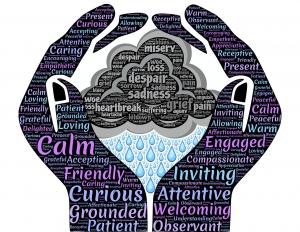Compassion, I believe, is born when love meets fear. But compassion unfolds, in four stages, in an epigenetic fashion – each subsequent stage incorporates but transcends the previous stage, just as tree leaves continue to keep alive their relationships with the twigs, branches, limbs, trunk and roots, even as they reach for the sky. The stages are as follows: first, a physiological response, followed by a psychological response, leading to a sociological response, culminating in a spiritual response. And each stage has its own beauty – and its own downsides. In fact, stages one through three, in the absence of stage four, can deplete the person who is emanating compassion.
- The Physiological Response
This involves taking on – consciously or unconsciously – the physical pain, illness or symptoms of another. Have you ever attempted to clear your throat on behalf of a speaker who has a ‘frog in her throat’? It’s the body (yours) literally trying to heal the other by temporarily assuming their condition. There is actually a neurological basis for this. By attaching electrodes to the crania of two volunteers, one of whom will then be subjected to a painful stimulus, the corresponding areas of the brain of the witness light up, as the victim is being hurt.
In “helping situations”, this is the equivalent of seeing somebody fall into a pit and, instead of throwing him a rope, you jump in beside him to show solidarity. It involves trying to be the source of healing rather than a channel for it.
- The Psychological Response
A surefire indication that you’re in stage two is that you become psychologically ‘disabled’ by your empathy. Once more, it’s trying to be the source not the channel, the pit-mate rather than the rope-thrower. It’s a classic example of codependency in which the other person’s anxiety and dysfunction rubs off on you. Contrary to popular belief, at this stage, a problem shared is a problem doubled.
It gets worse; you can become infected not just by the pain of an individual but even by global pain. The present political turmoil in our country has led to anxiety, anger and even rage at a national level like an infection that has gone viral (pun intended.)
There’s a condition which the DSM (the Bible of the psychological community) calls, “Borderline Personality Disorder” whose etiology is believed to come from the failure, on the part of the caregivers, to honor a young child’s appropriate boundaries. I once read a fascinating article in a journal of the Institute of Noetic Sciences that spoke of “Borderland Personality Disorder.” It’s when sensitive individuals become symptomatic of Gaia’s own distress. They are the prophets or early-warning-system of the stressed-out planet. And the picture may be confused with or amplified by the prophet’s personal issues.
While it may be useful, even admirable, to be the voice of the muted Pacha Mama, it’s rarely helpful to take on another’s personal pain.
- The Sociological Response
Now, the ‘caretaker’ is going to make interventions e.g., drive the patient to the hospital, cook their meals, help out financially, persuade their bosses not to fire them for poor performances or no-shows… Often, within a family, there is a ‘go-to’ member that has been anointed by fiat or precedent to be the rescuer. On the side of the ‘savior’, this can be a combination of genuine compassion and a defense mechanism to protect against the turmoil of a dysfunctional family.
Whatever its origin, left unchecked it can lead to burnout. Often, it is not appreciated or even recognized; and, occasionally, it is resented, especially by those who most ‘demand’ the help. Initially, it can be easier to do the job yourself than train, encourage or insist that the ‘victim’ do it. And it’s partially based on misunderstanding the meaning of ‘responsibility.’ The loving, compassionate rescuers often see themselves as somehow the cause of the other’s pain; or, at very least, that “it’s up to me to solve the problem.” In fact, responsibility simply means, ‘the ability to make responses.’ And sometimes the appropriate response is to say, “you need to do this yourself.”
- The Spiritual Response
This occurs when you can elevate above the details of a situation. Like an artist working on a large mural, you have to take several steps back in order to be able to grok the entire scope of your masterpiece, prior to re-engaging. This allows you to realize that you and all of the people whom you are trying to help are eternal beings, children of God whom She loves unconditionally; and all of whom will eventually find their way home. Allied to that, each soul, prior to incarnation, has crafted a life plan and underlined the lessons it hopes to master during the coming lifetime.
Sometimes, in our efforts to prevent people from experiencing the consequences of their own actions, we delay their progress. There’s a story I once heard, of a young boy who saw a monarch butterfly’s efforts to extricate herself from her cocoon. After a ten-minute struggle, she was still only halfway out and appeared to be in distress. So, the compassionate child broke open the remainder of the cocoon and set her free. The only problem was she was now crippled for life. She would never fly because it is precisely the struggle of emerging from the cocoon that releases the lactic acid into the muscles of her wings.
What Would Jesus Do?
Even better, what did Jesus do? There’s a wonderful story in all three Synoptic Gospels where Jesus is en route to heal the synagogue leader’s little daughter. A great throng is pressing in upon him as he hurries along, his mind fixed on what he must do when he gets there. A woman in the crowd who’s been hemorrhaging for twelve years and has spent all of her resources on doctors who failed to heal her, reaches down to touch the hem of Jesus’s robe, convinced that even that connection will cure her. And, indeed, it does.
However, Jesus is startled and swings around asking, “who touched me?” The disciples are bemused by the question and point out that there is a big, tightly-packed crowd about him. But he won’t be diverted. He says, “No, somebody touched me; power went out from me!” Shamefacedly, the woman came forward and explained the situation. Not only was this extremely embarrassing but, according to Jewish law, this bleeding woman was ritually unclean and should have sequestered herself. Anybody she touched was, ipso facto, also rendered unclean and would not be allowed to attend religious services until they had undergone a purification ceremony. Most of all, she had contaminated Jesus by intentionally touching his garments.
I’m sure she was expecting the crowd – and especially Jesus – to read her the riot act. For years, I couldn’t understand why he embarrassed her like that. Then, I finally got it. In one fell swoop, he was demonstrating that she was not unclean; she was a beloved daughter of God. Moreover, Jesus wanted her to realize that what she had just experienced was self-healing. In other words, he was telling her, ‘It was not I who healed you; it was your faith that did it. In future, you don’t need to project your own unrecognized ability onto any expert. You are a child of God, a divine being; own your power!” So, he wasn’t embarrassing her, he was empowering her, even as he taught the bystanders about the meshugas of uncleanness. He showed her that the healer’s job is not to be the benevolent master but, rather, to empower the patients so that they cease to regard themselves as helpless victims.
But there is another important lesson here. Why did Jesus say, ‘power has gone out of me’? My own theory is that when Jesus healed anybody, he acted as a channel to the Father. He was never claiming to be the source. So, his healings were always done by the conscious channeling of God-energy. In this incident, however, his focus was elsewhere and when the woman touched him, it caused a sudden and startling discharge which rocked him.
The lessons, then, are two-fold. First, realize that you are a channel, not the source. Otherwise, all compassionate outreach is going to drain your life force. And, second, when engaged in any healing exercise, public or private, be prepared for and fully aware of the flow of power
Conclusion
I live off the grid and depend on solar power. I had to carefully plan what my total wattage needs would be at peak usage e.g., the microwave uses about 1,500 watts, an average light bulb 60-150 watts, as well as my computer, printer, washing and drying machines, fridge etc. Only then, could I determine how many solar panels, inverters and batteries I needed.
You have to calibrate how much ‘solar power’ you have available so you don’t overload your system by overextending the wattage of your compassionate outreach. Compassion must not be confused with taking over the incarnational mission of another. When you’ve done what you can do, then you must – as they say in AA – ‘let go and let God.’ She who gave birth to the cosmos is probably in a far better place than you to determine the ideal timing and method of the healing.

















